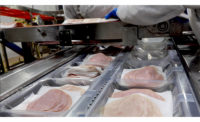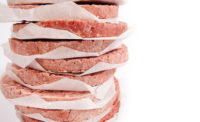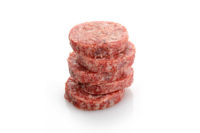The interleaving and stacking process is becoming increasingly automated, or at least is well suited for it.
Interleaving is the process of separating meat products, usually with a disposable paper sheet, to provide ease of preparation for consumers.
“For frozen interleaved products, the ability to separate the product more easily is related to material thickness and strength,” says Wes Osburn, Ph.D., associate professor, meat science, Texas A&M University, based in College Station, Texas. “This can reduce the time required to prepare product such as frozen beef patties.”
Many interleaved products can be used in autostackers prior to packaging to minimize portion control issues like misalignment of the interleaving material and minimize food safety concerns by reducing human contact with the product, he notes.
The materials used for interleaving should be in compliance with government regulations to reduce food safety risks, as well.
“Manufacturers can or are working toward traceability of the materials used for interleaved products to ensure product quality and safety,” too, says Osburn.
During the interleaving and stacking process, processors also need to be aware of their portion costs, so that production lines can run efficiently with minimal downtime.
“Selecting the right materials either pre-cut or roll stock of the right weight and thickness is critical to ensure that portioned products meet customer specifications, while keeping portion costs as low as possible,” says Osburn.
Interleaving and stacking, although a benefit for the end user, is certainly a challenge for manufacturing.
“The equipment used in these processes has definitely improved over the years,” says Mike Bliss, vice president of operations at Butterball, Kings Mountain, N.C. However, “interleaving and stacking will likely reduce line speed by as much as 50 percent, thus doubling your labor cost.”
Interleave and stacking can also increase giveaway primarily due to the added paper, he says.
To date, interleave and stacking equipment improvements have mostly focused on sanitary design and reliability, says Bliss.
“As most of these systems are found in RTE [ready to eat] areas, continuous improvement in sanitary design is critical,” notes Bliss. “Further improvements have been updates in the components and design of the equipment, which have minimized the effect of water intrusion.”
In the future, Bliss says he hopes to see a reusable solution, rather than just recyclable paper, as dividers.
“I think that there will also be an increased use of autostackers and robotics to minimize labor costs,”
says Osburn.
Robots, such as grippers and collaborative robots that work with humans, are already used to help food operations with portion control and food safety.
“I would suggest that yes, in order for companies to compete globally, robotics and automation will continue to grow like we’ve seen over the last few years,” says Bob Doyle, director of communications, Robotic Industries Association, based in Ann Arbor, Mich. “There have been a lot of advancements recently and will continue to do so with university research and in the startup community. Besides gripping and collaborative robots, the use of vision with robots is growing as well.” NP





Report Abusive Comment